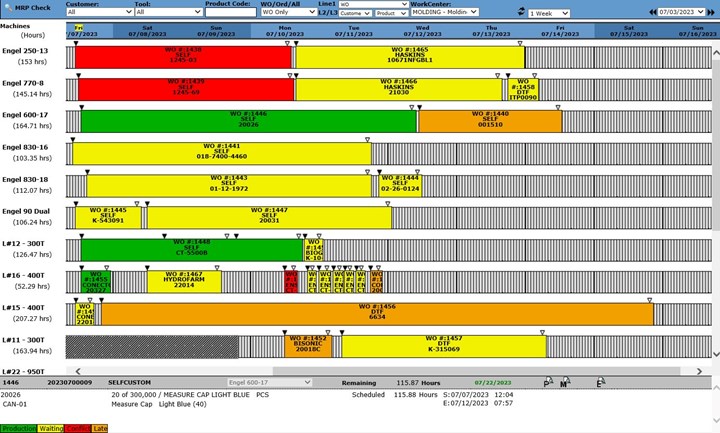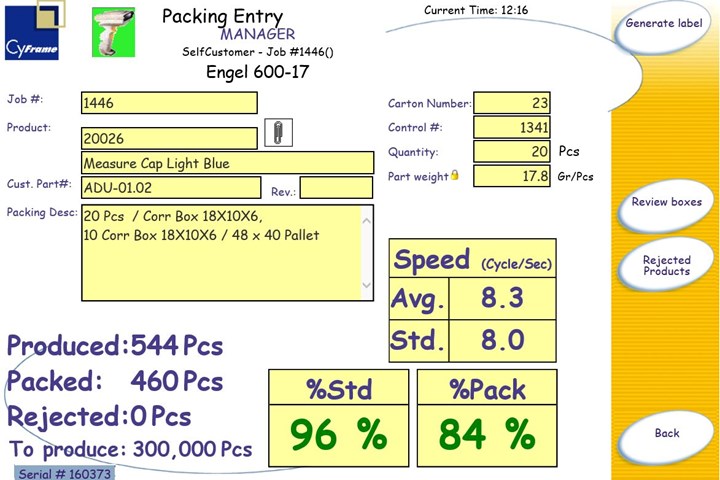Use Interactive Production Scheduling to Improve Your Plant's Efficiencies
When evaluating ERP solutions, consider the power of interactive production scheduling to effectively plan and allocate primary and secondary equipment, materials and resources on the overall production capacity of the business and conclude that this is a key area that cannot be overlooked.
Production planning and scheduling sits at the heart of all operations for plastics processors and poses unique challenges. To optimize overall production runs and improve lead times, it is crucial to identify the best-performing machines and tools for each product upfront. Additionally, processors must consider the availability of limited quantities of secondary equipment such as conveyors, grinders, calibrators, robots and coextruders, along with any scheduled maintenance or ongoing production runs.
Moreover, dynamic material requirements planning (MRP) calculations are essential to ensure the availability of materials and equipment when rescheduling work orders.
To effectively address these complexities, plastic processors require an enterprise resource planning (ERP) system with an interactive production scheduling module. Let’s explore the significance of interactive master production scheduling for plastic processors and the benefits it offers in improving lead times.
 The image above illustrates a fully graphic representation of production planning on a "drag-and-drop" production calendar. Photo Credit: Cyframe
The image above illustrates a fully graphic representation of production planning on a "drag-and-drop" production calendar. Photo Credit: CyframeOptimizing Production Runs and Equipment Utilization
With interactive production scheduling, plastic processors can make informed decisions about production runs, optimizing the utilization of machines and tools. By visualizing the availability and performance of each machine or tool, processors can identify the most efficient setup for a particular product.
This approach ensures that production runs are scheduled in a manner that maximizes output while meeting order due dates. The ability to plan and allocate resources effectively is crucial in minimizing downtime and optimizing the utilization of limited quantities of equipment.
Real-Time Availability and Conflicts Management
A robust interactive production scheduling module provides real-time visibility regarding the availability of machines, tools and secondary line equipment. Processors can instantly determine whether specific equipment is available or already assigned to other production runs or undergoing maintenance.
This information enables efficient decision-making when assigning equipment to different production runs. Furthermore, processors can identify and address conflicts in equipment availability, ensuring smooth operations and minimizing disruptions. By proactively managing equipment availability and conflicts, plastic processors can enhance lead times and optimize production efficiency.
Dynamic MRP Calculations and Alternative Recipes
Dynamic MRP calculations are a key component of interactive production scheduling. When scheduling work orders, the ERP system should automatically perform online calculations to verify the availability of required equipment and materials. This dynamic approach enables processors to make informed decisions on work order scheduling and ensure that all necessary resources are available. In cases where specific materials are unavailable, the system should provide the flexibility to suggest and implement alternative recipes to prevent production delays. This adaptability enables processors to maintain continuity in production and meet customer demands efficiently.

Production entry for the shop floor shown here provides information in real time for operators and supervisors. All the production information for operators is at the tips of their fingers with a touchscreen interface for production entry and label printing.
Visual Dashboard for Real-Time Monitoring
An essential feature of interactive production scheduling is a user-friendly visual dashboard. This tool provides a drag-and-drop interface that enables processors to easily manipulate and adjust production schedules. The visual dashboard offers a comprehensive overview of production runs, highlighting any potential deadline delays, material availability issues, or equipment conflicts. This real-time monitoring enables processors to quickly identify and resolve issues, ensuring optimal production planning and lead time improvements.
Choosing an ERP Solution With Interactive Production Scheduling
When selecting an ERP system for your plastic processing business, it is crucial to evaluate the capabilities of the production scheduling module. Ensure the ERP system offers an interactive and visually intuitive production scheduling tool that can handle the complexities specific to plastic processing such as tool or die efficiency by machine.
This core component should provide real-time availability and conflicts management, dynamic MRP calculations and the flexibility to handle alternative recipes. By incorporating these features, an ERP solution with interactive production scheduling empowers plastic processors to optimize production runs, improve lead times, ensure on-time delivery and enhance overall operational efficiency.
What to Look For
Interactive production scheduling plays a crucial role in optimizing production runs and overall plant throughput for plastic processors. By providing real-time visibility into equipment availability, managing conflicts, performing dynamic MRP calculations and offering a user-friendly visual dashboard, an ERP system with interactive production scheduling enables processors to streamline operations and make informed decisions with accuracy.
About the Author: Rick Dunne is the director of sales and a partner at CyFrame. He has over 20 years of experience dedicated to helping plastics processors identify and resolve inefficiencies in their operations through complete enterprise integration. His mission is to enable business owners to simplify their operations while better managing in real-time, with accurate shopfloor data to effectively strengthen their bottom lines and scale for growth.
__PRESENTRelated Content
Why Are There No 'Universal' Screws for All Polymers?
There’s a simple answer: Because all plastics are not the same.
Read MoreReduce Downtime and Scrap in the Blown Film Industry
The blown film sector now benefits from a tailored solution developed by Chem-Trend to preserve integrity of the bubble.
Read MoreHow to Select the Right Cooling Stack for Sheet
First, remember there is no universal cooling-roll stack. And be sure to take into account the specific heat of the polymer you are processing.
Read MoreSingle vs. Twin-Screw Extruders: Why Mixing is Different
There have been many attempts to provide twin-screw-like mixing in singles, but except at very limited outputs none have been adequate. The odds of future success are long due to the inherent differences in the equipment types.
Read MoreRead Next
Making the Circular Economy a Reality
Driven by brand owner demands and new worldwide legislation, the entire supply chain is working toward the shift to circularity, with some evidence the circular economy has already begun.
Read MoreBeyond Prototypes: 8 Ways the Plastics Industry Is Using 3D Printing
Plastics processors are finding applications for 3D printing around the plant and across the supply chain. Here are 8 examples to look for at NPE2024.
Read MoreLead the Conversation, Change the Conversation
Coverage of single-use plastics can be both misleading and demoralizing. Here are 10 tips for changing the perception of the plastics industry at your company and in your community.
Read More














